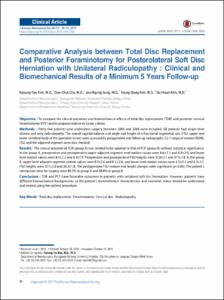KUMEL Repository
1. Journal Papers (연구논문)
1. School of Medicine (의과대학)
Dept. of Rehabilitation Medicine (재활의학)
Comparative Analysis between Total Disc Replacement and Posterior Foraminotomy for Posterolateral Soft Disc Herniation with Unilateral Radiculopathy : Clinical and Biomechanical Results of a Minimum 5 Years Follow-up
- Keimyung Author(s)
- Kim, Du Hwan
- Department
- Dept. of Rehabilitation Medicine (재활의학)
- Journal Title
- Journal of Korean Neurosurgical Society
- Issued Date
- 2017
- Volume
- 60
- Issue
- 1
- Abstract
- Objective : To compare the clinical outcomes and biomechanical effects of total disc replacement (TDR) and posterior cervical
foraminotomy (PCF) and to propose relative inclusion criteria.
Methods : Thirty-five patients who underwent surgery between 2006 and 2008 were included. All patients had single-level
disease and only radiculopathy. The overall sagittal balance and angle and height of a functional segmental unit (FSU; upper and
lower vertebral body of the operative lesion) were assessed by preoperative and follow-up radiographs. C2-7 range of motion (ROM),
FSU, and the adjacent segment were also checked.
Results : The clinical outcome of TDR (group A) was tended to be superior to that of PCF (group B) without statistical significance.
In the group A, preoperative and postoperative upper adjacent segment level motion values were 8.6±2.3 and 8.4±2.0, and lower
level motion values were 8.4±2.2 and 8.3±1.9. Preoperative and postoperative FSU heights were 37.0±2.1 and 37.1±1.8. In the group
B, upper level adjacent segment motion values were 8.1±2.6 and 8.2±2.8, and lower level motion values were 6.5±3.3 and 6.3±3.1.
FSU heights were 37.1±2.0 and 36.2±1.8. The postoperative FSU motion and height changes were significant (p<0.05). The patient’s
satisfaction rates for surgery were 88.2% in group A and 88.8% in group B.
Conclusion : TDR and PCF have favorable outcomes in patients with unilateral soft disc herniation. However, patients have
different biomechanical backgrounds, so the patient’s biomechanical characteristics and economic status should be understood
and treated using the optimal procedure.
- Keimyung Author(s)(Kor)
- 김두환
- Publisher
- School of Medicine
- Citation
- Kyoung-Tae Kim et al. (2017). Comparative Analysis between Total Disc Replacement and Posterior Foraminotomy for Posterolateral Soft Disc Herniation with Unilateral Radiculopathy : Clinical and Biomechanical Results of a Minimum 5 Years Follow-up. Journal of Korean Neurosurgical Society, 60(1), 30–39. doi: 10.3340/jkns.2015.0506.004
- Type
- Article
- ISSN
- 2005-3711
- Appears in Collections:
- 1. School of Medicine (의과대학) > Dept. of Rehabilitation Medicine (재활의학)
- 파일 목록
-
-
Download
 oak-2017-0224.pdf
기타 데이터 / 809.05 kB / Adobe PDF
oak-2017-0224.pdf
기타 데이터 / 809.05 kB / Adobe PDF
-
Items in Repository are protected by copyright, with all rights reserved, unless otherwise indicated.